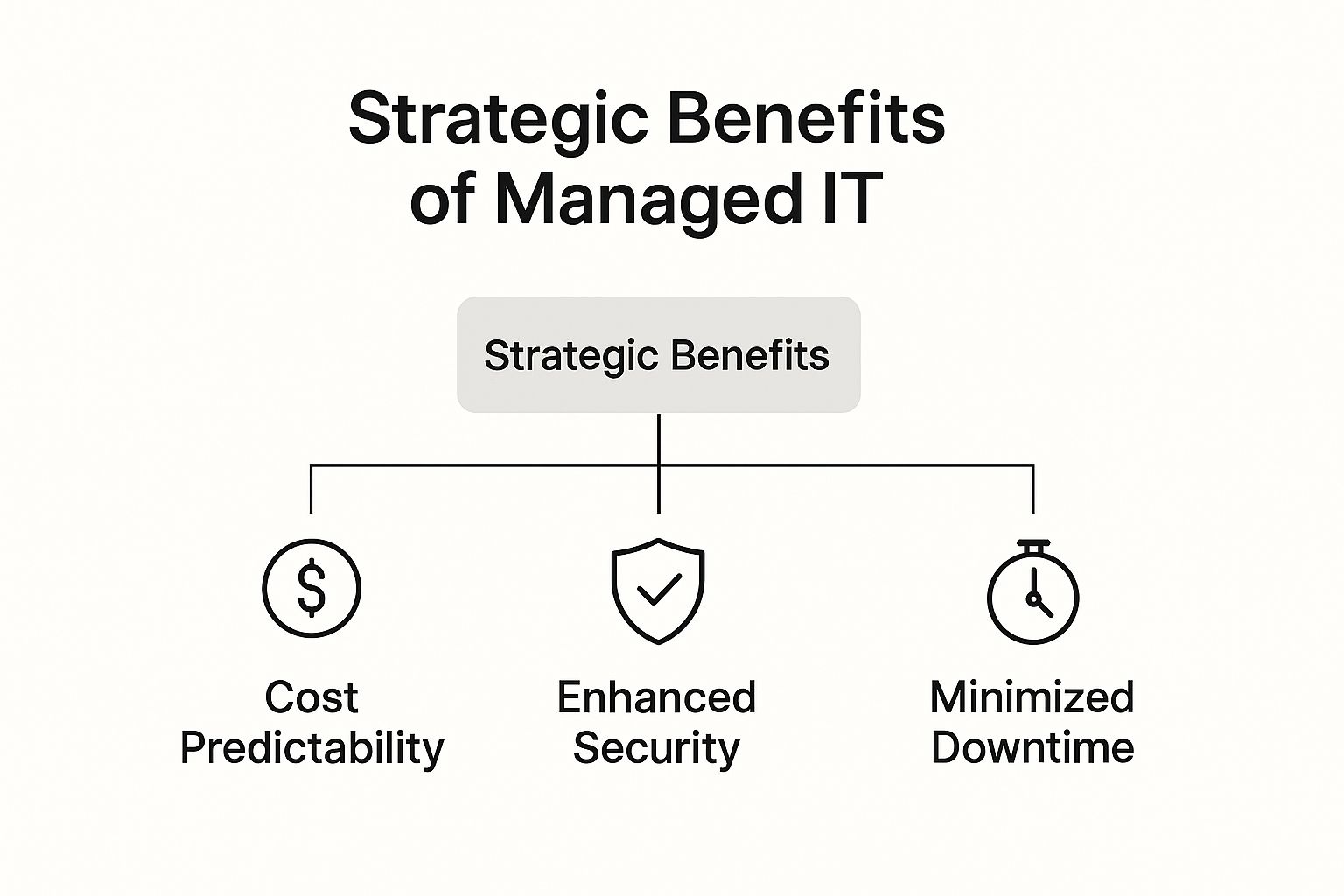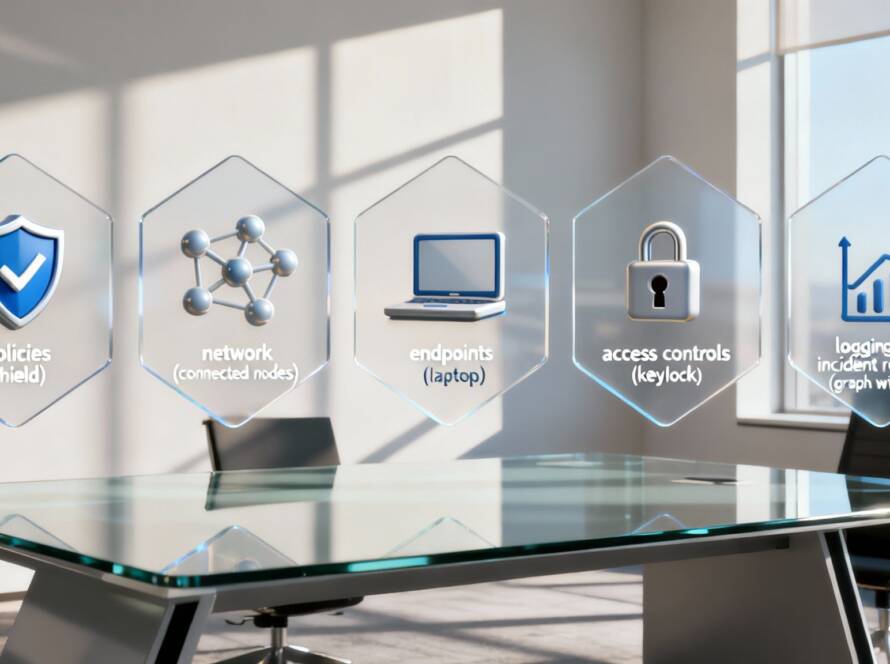Let's talk about what managed IT services really are and how they can make a world of difference for your business. Think of it as shifting from a firefighter to a fire marshal. Instead of just putting out fires when they flare up, you have an expert team actively working to prevent them from ever starting.
This approach involves partnering with a dedicated third-party firm that takes complete ownership of your IT infrastructure. They don't just wait for something to break; they work around the clock to keep your systems secure, efficient, and running smoothly.
What Are Managed IT Services for Businesses?

Here's a simple analogy: Imagine you own a high-performance car. The old way of thinking is to wait for the engine to sputter or a warning light to flash before taking it to the mechanic. The smarter, modern approach is to have a dedicated pit crew that constantly tunes the engine, checks the tires, and keeps everything in peak condition so you never break down in the first place.
That's precisely what a Managed Service Provider (MSP) does for your company's technology. You're not just hiring a technician; you're outsourcing your entire IT department to a team of seasoned experts. They become your partners, working behind the scenes to ensure your digital foundation is solid and aligned with where you want to take your business.
The Shift From Reactive to Proactive IT
For years, the standard for IT support was the "break-fix" model. Something breaks, you call for help, you wait, and eventually, it gets fixed. This method is not only frustrating but also incredibly inefficient, leading to unpredictable costs and costly downtime that grinds your operations to a halt.
Managed IT services completely flip that script. The core mission of an MSP is to stop problems before they can impact you. They accomplish this through a few key strategies:
- Continuous Monitoring: Your systems are watched 24/7. Potential issues are flagged and addressed long before they turn into full-blown emergencies.
- Preventative Maintenance: Think of it like a regular health check-up. Software gets updated, security patches are applied, and performance is optimized to keep your IT environment healthy and resilient.
- Strategic Planning: A good MSP acts as your virtual Chief Information Officer (vCIO), offering expert guidance to help you make smart technology investments that fuel growth, not hinder it.
This proactive philosophy is why the global managed services market is exploding, with projections showing it will reach USD 572.15 billion by 2033. Businesses are tired of reactive chaos and are moving toward predictable, scalable IT solutions. For a deeper dive, check out the full managed services market analysis.
By moving to a managed services model, businesses trade unpredictable repair bills and frustrating downtime for a stable, predictable monthly fee and uninterrupted productivity. It's about investing in prevention rather than paying for emergencies.
Ultimately, this frees you up. You and your team can get back to focusing on your core mission—serving customers and growing the business—without being constantly derailed by technology troubles.
To put it all in perspective, here’s a quick look at how the two models stack up against each other.
Comparing In-House IT with Managed Services
This table highlights the fundamental differences between sticking with a traditional in-house team and partnering with an MSP.
| Aspect | Traditional In-House IT | Managed IT Services |
|---|---|---|
| Cost Structure | High fixed costs (salaries, benefits, training) | Predictable, scalable monthly fee |
| Expertise | Limited to the skills of your hired staff | Access to a broad team of specialized experts |
| Availability | Typically 9-to-5, with gaps for vacation/sick days | 24/7/365 monitoring and support |
| Approach | Often reactive; fixing problems as they arise | Proactive; focused on prevention and optimization |
| Scalability | Slow and expensive to scale the team up or down | Easily scalable to match your business needs |
| Technology Access | Budget-dependent; may use outdated tools | Access to enterprise-grade tools and technology |
As you can see, the managed services model is built for modern business agility, offering a more flexible, cost-effective, and expert-driven approach to managing the technology you rely on every day.
Keep your business running without IT headaches.
GT Computing provides fast, reliable support for both residential and business clients. Whether you need network setup, data recovery, or managed IT services, we help you stay secure and productive.
Contact us today for a free consultation.
Call 203-804-3053 or email Dave@gtcomputing.com
The Strategic Benefits of Managed IT Services
Bringing on a managed IT services partner is so much more than just outsourcing your tech support. Think of it as a strategic shift—one that delivers real, measurable advantages that go straight to your bottom line, strengthen your security, and clear the path for growth. When you partner with a Managed Service Provider (MSP), you're not just hiring a vendor; you're gaining a proactive ally whose main job is to keep your technology running smoothly.
One of the first things you'll notice is the shift to cost predictability. The old break-fix model is a financial rollercoaster. One month might be quiet with low IT costs, but the next could bring a catastrophic server failure with a massive, unplanned bill. That kind of volatility makes budgeting a nightmare and can put a serious strain on your cash flow when you least expect it.
Managed IT services swap that chaos for a steady, predictable operational expense. You pay a consistent monthly fee that covers all the maintenance, monitoring, and support you need. This lets you forecast your IT spending with confidence, treating it just like any other utility bill. It makes financial planning a whole lot simpler.
This infographic lays out the core benefits you get from a great managed IT partnership.

As you can see, these advantages don't exist in a vacuum. They all work together to create a business that's more efficient and much harder to knock down.
Fortifying Your Digital Defenses
In today's world, solid cybersecurity isn't a "nice-to-have"—it's an absolute necessity. But for most small and medium-sized businesses, building an in-house security team with enterprise-level tools is simply too expensive. This is where an MSP gives you a serious competitive edge.
MSPs provide access to a deep bench of security specialists and advanced technologies that would otherwise be out of reach. This isn't just about installing antivirus software; it's about a comprehensive security strategy that includes:
- Proactive Threat Hunting: Experts actively looking for weaknesses and potential threats before criminals have a chance to exploit them.
- 24/7 Security Monitoring: Around-the-clock vigilance over your network to spot and shut down suspicious activity the moment it happens.
- Compliance Management: Help navigating the complex rules of industry regulations (like HIPAA or PCI DSS) to ensure you're meeting all your legal and ethical duties.
To dig deeper into why this multi-layered defense is so important, check out our guide on why cybersecurity is non-negotiable for small businesses. A proactive security posture like this dramatically lowers your risk of suffering a data breach that could cripple your business.
Maximizing Uptime and Efficiency
Every single minute your systems are down, you're losing money. Downtime brings productivity to a screeching halt, frustrates your customers, and can do lasting damage to your reputation. A core mission of any good MSP is to minimize—and ideally, eliminate—unplanned downtime.
By constantly monitoring your systems and performing preventative maintenance, an MSP makes sure everything is running at its best. This relentless focus on uptime means your team can work without interruption, which directly boosts both your productivity and your profitability.
This demand for reliable and secure IT is fueling incredible growth in the market. In the U.S. alone, the managed services industry is expected to hit USD 69.55 billion and is projected to climb to USD 116.25 billion by 2030, growing at a powerful 10.82% each year. According to MSP growth statistics on infrascale.com, this boom is driven by businesses like yours that are making cybersecurity, cloud management, and infrastructure a top priority.
Finally, working with an MSP gives you on-demand access to a whole team of specialists. Whether you need an expert in cloud migration, network architecture, or data analytics, the knowledge is there right when you need it. This agility allows you to scale your technology as your business grows, ensuring your IT infrastructure is an engine for your success, not a bottleneck holding you back.
Keep your business running without IT headaches.
GT Computing provides fast, reliable support for both residential and business clients. Whether you need network setup, data recovery, or managed IT services, we help you stay secure and productive.
Contact us today for a free consultation.
Call 203-804-3053 or email Dave@gtcomputing.com
What’s Actually Inside a Managed Services Plan?

So, you're thinking about bringing a Managed Service Provider (MSP) on board. What are you actually paying for? It’s not a single product, but a whole partnership wrapped up in a subscription. Think of it as having an entire IT department on call, completely focused on keeping your business’s technology healthy and humming along.
A solid plan for managed IT services for businesses is built on several key pillars. Each one targets a critical piece of your IT infrastructure, and they all work together to build a stable, secure, and efficient tech environment. Let’s pull back the curtain and look at the core services you should expect.
24/7 Network Monitoring and Management
This is the absolute foundation of any good managed services plan. Imagine a security guard who never sleeps, constantly watching every digital door and window of your business. That’s exactly what 24/7 network monitoring provides.
Your MSP uses sophisticated tools to keep a constant watch on the health of your entire network—servers, firewalls, workstations, you name it. The system is designed to spot trouble brewing, like a server running low on memory or a weird spike in network traffic, long before it can knock you offline or lead to a breach. This proactive stance is what prevents so much costly downtime.
Proactive System Maintenance and Updates
Just like your car needs regular oil changes to keep running smoothly, your technology needs consistent, behind-the-scenes care. An MSP handles all of this for you, ensuring your systems are always in peak condition.
This isn’t just about fixing things when they break; it's about preventing them from breaking in the first place. Key maintenance tasks include:
- Patch Management: Systematically applying the latest security patches to software and operating systems. This closes the vulnerabilities that cybercriminals are always looking to exploit.
- System Optimization: Regularly cleaning out digital clutter, checking for performance bottlenecks, and making sure all your hardware is running as it should.
- Software Updates: Managing updates for your core business apps to ensure you always have the latest features and security fixes.
This kind of preventative care is what keeps your technology reliable and fast day in and day out.
Robust Data Backup and Disaster Recovery
Ask yourself this: what would happen if a fire, flood, or ransomware attack wiped out all of your business data? For most companies, it’s a nightmare scenario—one they might never recover from. A core part of any managed IT plan is creating a safety net for your data.
An MSP doesn't just save files to an external drive now and then. They build a comprehensive backup and disaster recovery (BDR) strategy designed to keep your business running, no matter what happens.
This usually means setting up regular, automated backups of all your critical data and systems. These backups are often stored in two places: locally for quick restores and securely in the cloud to protect against a physical disaster at your office. A good provider also tests these backups to make sure they'll actually work when you need them most. Building in these safeguards is essential, and you can learn more about creating resilient systems by reading our guide on what network redundancy is and why it matters.
Multi-Layered Cybersecurity Services
In the face of today’s cyber threats, a single antivirus program just doesn't cut it anymore. MSPs bring a multi-layered security strategy to the table, creating a "defense-in-depth" approach that protects your business from all angles.
This includes a whole suite of essential security tools:
- Managed Antivirus and Anti-Malware: Enterprise-grade protection that’s centrally managed and always kept up-to-date.
- Firewall Management: Professional configuration and ongoing monitoring of your network firewall to block unauthorized access.
- Email Security: Advanced filtering that weeds out phishing scams, spam, and dangerous attachments before they ever reach your team’s inboxes.
Responsive Help Desk Support
When an employee runs into a tech problem, they need help, and they need it fast. A key benefit of a managed services plan is giving your team a direct line to IT experts who can solve their issues and get them back to work.
Instead of your team getting stuck waiting for an overwhelmed in-house person to free up, they can just submit a ticket or call a dedicated support line. This immediate access to help minimizes frustration and keeps everyone productive.
While the specifics of each plan can vary, most reputable MSPs build their offerings around these core components. The table below breaks down how each service addresses a common business pain point.
Core Components of Managed IT Service Plans
| Service Component | Description | Business Benefit |
|---|---|---|
| 24/7 Monitoring | Constant surveillance of network health and performance. | Prevents downtime by catching issues before they escalate. |
| Proactive Maintenance | Regular updates, patching, and system tune-ups. | Keeps systems running fast, reliably, and securely. |
| Data Backup & Recovery | Automated, multi-location backups and a recovery plan. | Ensures business continuity in the event of data loss or disaster. |
| Cybersecurity Suite | Managed firewall, antivirus, and email security. | Protects against a wide range of cyber threats like malware and phishing. |
| Help Desk Support | On-demand technical assistance for your employees. | Minimizes productivity loss and employee frustration from IT problems. |
| Strategic IT Consulting | High-level guidance on technology planning and budgeting. | Aligns your technology investments with your long-term business goals. |
Together, these services provide a complete technology management solution that goes far beyond simply fixing broken computers.
Strategic IT Consulting (vCIO)
Finally, the best MSPs do more than just manage your tech—they help you plan for the future. This service, often called a virtual Chief Information Officer (vCIO), gives you access to executive-level IT expertise without the hefty salary of a full-time hire.
Your vCIO gets to know your business inside and out. They help you create a technology roadmap that aligns with your company's goals, offering advice on budgeting, adopting new tech, and forming a long-term IT strategy. This transforms IT from a necessary expense into a powerful tool for growth.
Keep your business running without IT headaches.
GT Computing provides fast, reliable support for both residential and business clients. Whether you need network setup, data recovery, or managed IT services, we help you stay secure and productive.
Contact us today for a free consultation.
Call 203-804-3053 or email Dave@gtcomputing.com
How to Choose the Right Managed Service Provider
Choosing a provider for managed IT services for businesses isn't like picking a software subscription. Think of it more like bringing a new partner into your leadership team. This single decision will have a huge impact on your company's security, day-to-day efficiency, and even your ability to scale, so you have to look past the monthly price tag.
A great Managed Service Provider (MSP) truly becomes an extension of your own team—they are genuinely invested in seeing you succeed. The wrong choice, on the other hand, can quickly turn into a nightmare of recurring technical glitches, gaping security holes, and constant frustration for your staff.
The goal is to find a partner who fits your company culture, understands what you're trying to achieve, and has the technical chops to make it happen. This means you'll need to do some digging and ask the tough questions. Let's break down exactly what to look for.
Evaluate Technical Expertise and Industry Experience
Not all MSPs are built the same. Their skills and experience can be wildly different, so your first job is to confirm they actually have the right expertise for your specific business.
Start by looking for proof of their team’s qualifications. Don't be shy about asking for the details on their technicians' certifications. Are they certified in critical areas like networking (think Cisco), cloud platforms (like Microsoft Azure), or cybersecurity? These credentials show a real commitment to professional standards and staying current.
Just as important is their direct experience in your industry. An MSP that works with a dozen dental offices will already know the ins and outs of HIPAA compliance. One that specializes in law firms will be deeply familiar with the specific software and data privacy rules that govern the legal field.
- Ask for Case Studies: Have them show you real-world examples of how they’ve helped businesses just like yours.
- Discuss Your Tech Stack: Make sure they have hands-on experience with the exact software and hardware your business depends on.
- Verify Compliance Knowledge: If you're in a regulated industry like healthcare or finance, they should be able to talk fluently about the compliance frameworks you live by.
An MSP with the right industry experience doesn't just fix what's broken; they anticipate problems and suggest solutions that make sense for how your business actually works.
Scrutinize the Service Level Agreement
The Service Level Agreement (SLA) is the single most important document you'll sign. It’s the contract that spells out, in black and white, exactly what you can expect. A vague or wishy-washy SLA is a massive red flag.
The SLA isn't just a piece of paper; it's your service guarantee. It must clearly define response times, resolution times, and what happens if the provider fails to meet those promises.
Look for specifics you can measure. For example, what is their guaranteed response time for a "critical" issue, like your main server going down? How is that different from a "low-priority" ticket, like setting up a new employee's email? There should be zero ambiguity.
The rapid growth in this market shows just how vital these services have become. The global managed services market is expected to grow by USD 217 billion, fueled by businesses adopting more complex technologies. As companies rely more on tech, the need for a rock-solid service agreement becomes absolutely critical. You can learn more about the managed services market trends and see why a strong SLA is non-negotiable.
Check References and Reputation
Finally, you need to get past the sales pitch and find out what it's really like to be their client. The best way to do that is to talk to the people who are already paying them.
Ask the MSP for a list of current client references—and then actually call them. A few prepared questions will give you incredible insight:
- How fast and helpful is their support desk, really?
- Do they communicate clearly and proactively, especially about potential problems?
- Have they ever given you strategic advice that helped your business grow or save money?
- What was the onboarding process like? Did they make it easy?
Online reviews can be helpful, but a real conversation gives you a much better feel for the company. Choosing the right managed IT services provider is a foundational business decision. By carefully vetting their expertise, digging into their SLA, and checking their reputation, you can forge a partnership that will support and strengthen your business for years.
Keep your business running without IT headaches.
GT Computing provides fast, reliable support for both residential and business clients. Whether you need network setup, data recovery, or managed IT services, we help you stay secure and productive.
Contact us today for a free consultation.
Call 203-804-3053 or email Dave@gtcomputing.com
The Onboarding Journey with a New MSP

Deciding to partner with a Managed Service Provider (MSP) is a big move. So, what happens after you sign on the dotted line? A smooth, well-organized onboarding process is the mark of a truly professional MSP, and it’s what sets the stage for a successful long-term relationship.
The switch to managed IT services for businesses shouldn't feel like a chaotic overhaul. Instead, think of it as a carefully planned upgrade. A good provider will have a clear, step-by-step roadmap that replaces uncertainty with confidence, ensuring the transition from your old IT setup to their proactive support is seamless.
This whole process is a team effort, built on clear communication and solid planning. Let's walk through the key phases you can expect.
Phase 1: Initial Technology Assessment
Before an MSP can manage your technology, they need to know it inside and out. The very first step is a deep dive into your entire IT infrastructure. It’s like a comprehensive health check-up for your company's digital backbone.
Technicians will carefully map out everything—from your servers and workstations to network hardware and cloud services. The goal here is to spot potential risks, find inefficiencies, and get a perfect inventory of what you're working with.
This assessment usually covers:
- Hardware and Software Audit: A full catalog of every device, software license, and its current update status.
- Network Analysis: An examination of your network's layout, security, and performance.
- Security Vulnerability Scan: Proactively looking for any weaknesses that cyber threats could exploit.
This groundwork gives the MSP the information they need to build a support plan that fits your business perfectly from day one.
Phase 2: Strategic Planning and Deployment
With a complete picture of your IT environment, the MSP shifts into planning mode. The main goal is to get everything switched over with minimal disruption to your daily business. After all, you can't afford to shut down for a tech upgrade, and a great provider knows this.
They’ll work with you to schedule the deployment of their management tools at the most convenient times, like after hours or over a weekend. This is when they install lightweight monitoring agents on your computers and servers. These agents are their eyes and ears, letting them keep an eye on system health and security without getting in your team’s way.
A well-planned deployment should be almost invisible to your staff. The idea is for your team to leave work one day and come back the next to a more reliable and secure IT system, without ever feeling the transition.
Phase 3: The First 30 Days and Team Training
The first month is all about stabilizing the new partnership. During this time, the MSP will be fine-tuning their monitoring tools, fixing any lingering issues found during the assessment, and establishing a performance baseline for your network. It's also when your team gets acquainted with the new support system.
Good training is key. Your provider should give everyone clear instructions on how to use their help desk. This typically includes:
- How to Submit a Support Ticket: Walking through the process for getting help, whether it's by email, a web portal, or a phone call.
- Understanding Priority Levels: Explaining how issues are classified so that urgent problems get the immediate attention they need.
- Accessing IT Resources: Guiding your team on any new tools or security practices they need to adopt.
This period is also the perfect time to tackle bigger projects, like necessary system upgrades. For example, an MSP can help you smoothly manage the transition from Windows 10 to Windows 11 for businesses, making sure all workstations are updated securely and without a hitch.
By setting up clear communication and empowering your staff from the start, the onboarding journey builds a strong foundation for a productive IT partnership that lasts.
Keep your business running without IT headaches.
GT Computing provides fast, reliable support for both residential and business clients. Whether you need network setup, data recovery, or managed IT services, we help you stay secure and productive.
Contact us today for a free consultation.
Call 203-804-3053 or email Dave@gtcomputing.com
Common Questions About Managed IT
Diving into managed IT services for businesses is a big step, and it’s natural to have questions. You're thinking about changing a fundamental part of how your company operates, so you need to be sure. Let's tackle some of the most common things business owners ask when they're considering this move.
My goal here is to cut through the noise and give you clear, straightforward answers. This should help you figure out if teaming up with a Managed Service Provider (or MSP) is the right call for you.
How Much Do Managed IT Services Cost?
Let's get straight to it: what's the price tag? This is usually the first question on everyone's mind. The honest answer is, it depends. Managed IT isn't a one-size-fits-all product; the cost is tailored to what your business actually needs.
Most providers use a few standard pricing models that give you a predictable, flat monthly fee. This is a game-changer because it turns your IT costs into a stable operational expense, ending the surprise bills that come with unexpected tech failures.
Here are the most common ways MSPs structure their pricing:
- Per-User Model: You pay a set fee every month for each person on your team. This model works really well when your employees use multiple devices (like a laptop, desktop, and phone).
- Per-Device Model: The fee is based on how many pieces of hardware you have. Every server, workstation, and network switch has a fixed monthly cost.
- Tiered Plans: This is like a subscription service with different levels. A basic tier might cover just monitoring and maintenance, while a premium tier could add things like advanced cybersecurity, strategic planning, and 24/7 support.
The final number will always depend on a few key things: how many people are on your team, how complex your network is, and the level of security your business requires.
Is My Business Too Small for an MSP?
This is a myth I hear all the time. There's a common belief that managed services are only for big corporations with sprawling IT departments. The truth is, small businesses often get the biggest bang for their buck from an MSP.
Think about it. Without a dedicated IT partner, small companies are usually stuck in a reactive "break-fix" loop—you only call for help when something is already broken. That's not just disruptive; it's expensive. A single server crash or a security breach can be a knockout blow for a small business running on thin margins.
An MSP gives a small business access to the kind of powerful tools, deep expertise, and robust security that would normally be way too expensive to build in-house. It puts you on a level playing field with bigger competitors, but without the massive overhead.
What's the Real Difference Between an MSP and a Break-Fix Tech?
This question cuts right to the core of what managed services are all about. While both an MSP and a break-fix technician fix IT problems, their entire approach is worlds apart.
A break-fix technician is reactive. They're like an on-call plumber—you only call them when a pipe has burst and your floor is flooded. Their job starts after the damage is already done and your business has ground to a halt.
An MSP, on the other hand, is proactive. Think of them as your company's personal trainer, focused on keeping your systems healthy and strong so you avoid injuries in the first place. They are constantly monitoring, performing regular maintenance, and planning for the future.
This isn't just about fixing problems; it's about preventing them. It’s the difference between having a technology partner who is genuinely invested in your success versus a repair person who only makes money when you're in trouble.
Keep your business running without IT headaches.
GT Computing provides fast, reliable support for both residential and business clients. Whether you need network setup, data recovery, or managed IT services, we help you stay secure and productive.
Contact us today for a free consultation.
Call 203-804-3053 or email Dave@gtcomputing.com
Focus on Growth, Not IT Headaches
Deciding to bring on a managed IT services team is a lot more than just a small operational tweak—it’s a major strategic investment in your company's future. When you hand off the day-to-day tech grind to a dedicated partner, you're not just fixing problems. You're getting ahead of them.
This move instantly makes your IT budget predictable. No more surprise invoices when a server unexpectedly dies or a critical piece of software fails. You also gain access to enterprise-level cybersecurity and a deep bench of specialists, something that would cost a fortune to build and maintain on your own. This isn't just about convenience; it's about building a fortress around your data and your reputation.
Let Technology Fuel Your Mission
The biggest win, though? You get your time and focus back. Instead of your team getting pulled into troubleshooting network glitches or managing software updates, they can zero in on what actually grows the business.
- Driving Innovation: You can finally work on that new product idea without worrying if your tech can keep up.
- Serving Your Customers: Your focus can be on delivering an amazing customer experience, knowing your systems are solid and reliable.
- Pursuing Growth: When you're ready to scale or enter a new market, your technology is ready to grow right alongside you.
Entrusting your IT to an expert partner transforms technology from a source of constant distraction into a powerful catalyst for success. It allows you to stop managing headaches and start building momentum.
Your technology should be a tool that helps you succeed, not an obstacle you constantly have to climb over. Making this shift ensures your IT infrastructure is the solid foundation you need to support your company's growth, letting you finally focus on the bigger picture.
Keep your business running without IT headaches.
GT Computing provides fast, reliable support for both residential and business clients. Whether you need network setup, data recovery, or managed IT services, we help you stay secure and productive.
Contact us today for a free consultation.
Call 203-804-3053 or email Dave@gtcomputing.com



